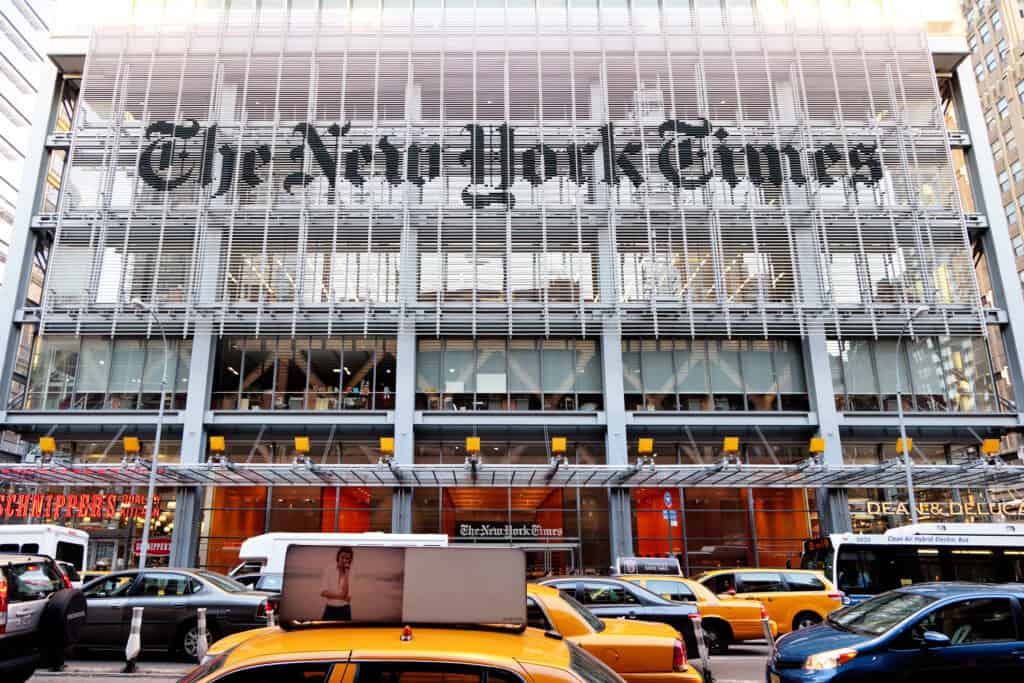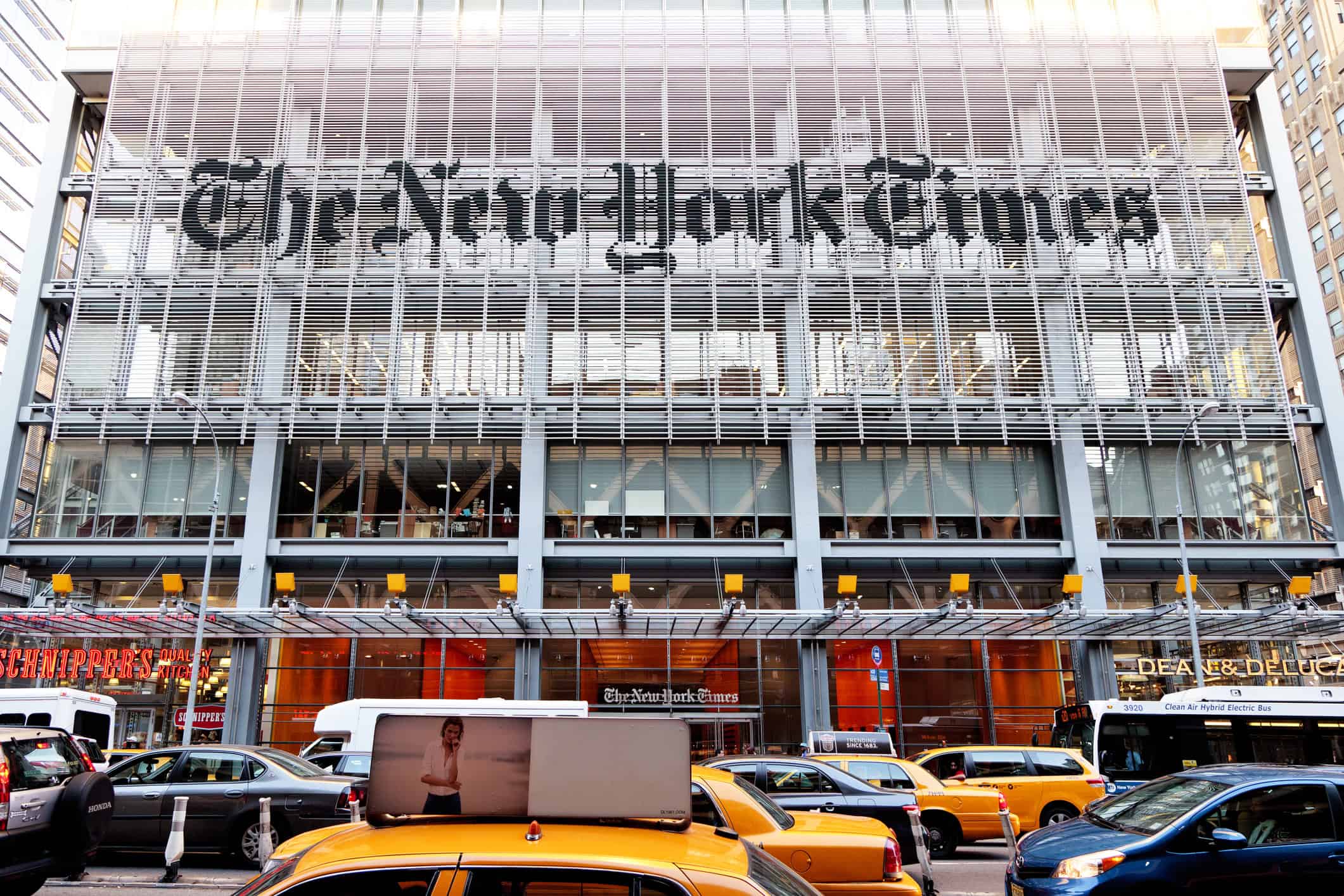
New York
The New York Times responds to 'The Anti-Trans Hate Machine' episode 'Capturing The New York Times' and TransLash Media shares follow up questions.

New York, USA – June 7, 2014: Facade of the New York Times headquarters building in Midtown Manhattan. Photo credit: mizoula
The New York Times’ Statement in response to The Anti-Trans Hate Machine: a Plot Against Equality Season 2 Episode 5 Capturing The New York Times:
“We reject the claim that our coverage is biased. The role of an independent news organization is to report on issues of public importance and follow the facts where they lead.
As part of that mission, we’ve reported fully and fairly on transgender issues ranging from challenges and prejudice faced by the community, to the fight for expanding rights and freedoms, and open debates about care. Our coverage has been rigorously reported and edited, respectful of the people we’re covering and sensitive to the moment. It is providing a vital service to the LGBTQ+ community and our readership.
The New York Times has published hundreds of articles — with a collective word count well over 330,000 — specifically on discrimination against transgender people and/or anti-transgender legislation since January 2020.”
TransLash’s Unanswered Questions of The New York Times
#1
How does The New York Times respond to our reporting that found the paper is laundering the myth of social contagion and other anti-trans disinformation in its pages? If the paper claims not to have an anti-trans bias, why doesn’t it properly contextualize or qualify anti-trans pseudoscience nor the organizations like Genspect which propagate it?
#2
Is it true that specific people in Times leadership believe that transness is a social contagion and are more inclined to run stories that support the idea of social contagion and to do so without the application of the paper’s own journalistic standards?
#3
How has The New York Times responded internally to the concerns raised by staff about anti-trans bias and the paper not meeting its own journalistic standards on this topic?
#4
Our reporting found that staff who go through the existing internal channels to hold The New York Times to its own journalistic standards are not taken seriously. And those who continually push for journalistic integrity on this issue internally are met with negative professional consequences by management. Why is that?
#5
Can The Times provide insight into why Dean Baquet shared Harper’s email with the masthead?
#6
Can The Times provide any insight into why Emily Bazelon’s piece “The Battle Over Gender Therapy” received the Publisher’s Award? How does A.G. Sulzberger respond to our reporting that found the piece elevates disinformation and gives credibility to the organizations and sources spreading that disinformation without qualification nor context?
#7
How does The New York Times respond to reporting from us that the Chairman AG Sulzberger is trying to push the paper to the right in order to appeal to right-wing audiences?
#8
Is it true that members of The Times masthead read and shared anti-trans posts from Bari Weiss’ substack with other masthead members?
#9
As we reported, the New York Times dedicated 10,000 words of front-page coverage to raising concerns about medical care for trans youth in 2022, yet zero front page stories were dedicated to the nationwide, persistent and coordinated attacks to take away gender affirming healthcare from trans youth in that year. Given what stories the New York Times is choosing to center and elevate, how can the New York Times deny anti-trans bias in its coverage?
#10
Why is The New York Times conflating the contributor letter raising journalistic concerns with the GLAAD letter, by explicitly ignoring the former? Do leaders at The New York Times not believe that there was a difference between them? And was the lack of silence on the contributor letter a tactic to avoid addressing their points?
#11
Is the New York Times concerned that its reporting—specifically its lack of contextualization of organizations and people who are skeptical, questioning or hostile to gender-affirming care—has been used or cited by anti-trans activists and lawmakers intent on denying health care and other rights to transgender people? Specifically, Texas lawmakers citing Times reporting in court to bolster their argument against families of trans youth, or the Attorney General of Arkansas who cited biased New York Times articles in an amicus brief supporting an Alabama law that criminalizes doctors and parents who provide trans youth with healthcare. What actions is The New York Times considering to possibly address those concerns?
#12
One concern we heard from staff was that trans voices were often left out of key conversations. Our research has found that to be largely accurate. Of the 330,000 words that the New York Times dedicated to attacks on transgender people and our rights, do you have data on how often the voices of transgender people were included in those pieces?
#13
One common theme throughout our investigation was that staffers said masthead leadership—including Carolyn Ryan, Cliff Levy and Pamela Paul—refused to apply the paper’s rigorous editorial standards to unsubstantiated or disputed claims about transgender care, and/or routinely defended stories that misidentified anti-trans activists as experts who spoke on those matters. Can you clarify the standard as it exists now? Can the NYT provide other examples where the political motivations of activists were not disclosed in favor of generic titles of authority?
#14
Did anyone on the masthead, including Pamela Paul, ever raise the factual and ethical concerns to Jesse Signal that were brought up internally by Times Out and other staff members about his review of Helen Joyce’s book?
#15
Did Jesse Singal’s article ever go through the standard fact checking process and, if so, were there ever any issues raised by that fact check?
#16
In the statement you provided, the New York Times defends its reporting on trans issues, saying the paper has published hundreds of articles “specifically on discrimination against transgender people and/or anti-transgender legislation since January 2020.” TransLash’s extensive analysis of New York Times coverage of trans issues found disinformation and anti-trans pseudoscience to be regularly elevated in these articles without correction or context. How does the New York Times respond to these findings and does the New York Times have any standards or guidelines for correcting anti-trans bias in its pages?
Listen to the episode of The Anti-Trans Hate Machine where TransLash investigates The New York Times:
Access the full transcript for Capturing The New York Times here.
Did you find this resource helpful? Consider supporting TransLash today with a tax-deductible donation.